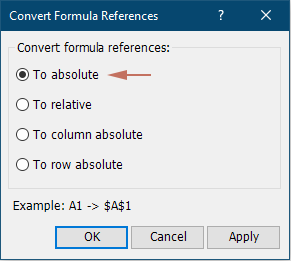วิธีทำให้การอ้างอิงเซลล์สูตรคงที่ใน Excel
ในบทช่วยสอนนี้ เราจะสาธิตวิธีเปลี่ยนการอ้างอิงเซลล์ในสูตรเป็นการอ้างอิงแบบคงที่ (สัมบูรณ์) เพื่อป้องกันไม่ให้มีการเปลี่ยนแปลงเมื่อคัดลอกสูตรไปที่อื่น
- สูตรทางด้านซ้ายเลื่อนการอ้างอิงอัตราคิดลดลงในแต่ละแถวอย่างไม่ถูกต้อง เมื่อคัดลอกมาจาก D3 ไปยัง D4 และ D5มันอ้างอิง F4 และ F5 แทนอัตราคิดลดคงที่ใน F3ส่งผลให้การคำนวณไม่ถูกต้องค่ะ D4 และ D5.
- ทางด้านขวาของภาพหน้าจอ $ F $ 3 เป็นการอ้างอิงคงที่ (สัมบูรณ์) มันเก็บอัตราคิดลดที่เชื่อมโยงกับเซลล์ F3ไม่ว่าสูตรจะถูกคัดลอกไปที่ใดภายในเวิร์กบุ๊กก็ตาม ดังนั้น การคัดลอกสูตรลงในคอลัมน์จะทำให้อัตราคิดลดสอดคล้องกันสำหรับสินค้าทั้งหมด

รักษาค่าคงที่อ้างอิงเซลล์สูตรด้วยคีย์ F4
หากต้องการรักษาการอ้างอิงเซลล์ให้คงที่ในสูตร เพียงเพิ่มสัญลักษณ์ $ หน้าตัวอักษรคอลัมน์และหมายเลขแถวโดยกดปุ่ม F4 ต่อไปนี้เป็นวิธีดำเนินการ
- คลิกเซลล์ที่มีสูตร
- ในแถบสูตร ให้วางเคอร์เซอร์ภายในการอ้างอิงเซลล์ที่คุณต้องการให้คงที่ ที่นี่ฉันเลือกข้อมูลอ้างอิง F3.
- กด F4 ปุ่มเพื่อสลับประเภทการอ้างอิงจนกว่าคุณจะไปถึงการอ้างอิงแบบสัมบูรณ์ ซึ่งจะเพิ่ม a เครื่องหมายดอลลาร์ ($) ก่อนตัวอักษรประจำคอลัมน์และหมายเลขแถว ที่นี่ F3 จะเปลี่ยนเป็น $ F $ 3- จากนั้นกด Enter เพื่อยืนยันการเปลี่ยนแปลง

ในตอนนี้ จะเก็บอัตราคิดลดที่เชื่อมโยงกับเซลล์ F3 ไว้ ไม่ว่าจะคัดลอกสูตรไปที่ใดภายในเวิร์กบุ๊กก็ตาม

คลิกเพียงไม่กี่ครั้งเพื่อทำให้การอ้างอิงเซลล์ทั้งหมดอยู่ในช่วงสัมบูรณ์
วิธีการข้างต้นช่วยจัดการเซลล์ทีละเซลล์ หากคุณต้องการใช้การอ้างอิงแบบสัมบูรณ์กับหลายเซลล์พร้อมกัน ขอแนะนำอย่างยิ่งให้ใช้ดังนี้ แปลงอ้างอิง คุณลักษณะของ Kutools สำหรับ Excel- ด้วยคุณลักษณะนี้ คุณสามารถทำให้การอ้างอิงเซลล์ทั้งหมดในช่วงเซลล์หรือหลายช่วงเซลล์เป็นแบบสัมบูรณ์ได้อย่างง่ายดายด้วยการคลิกเพียงไม่กี่ครั้ง
หลังจาก การติดตั้ง Kutools สำหรับ Excelไปที่ Kutools เลือก More > แปลงอ้างอิง เพื่อเปิด แปลงการอ้างอิงสูตร กล่องโต้ตอบ จากนั้นคุณจะต้อง:
- เลือกช่วงหรือหลายช่วงที่มีสูตรที่คุณต้องการให้การอ้างอิงเซลล์ทั้งหมดคงที่
- เลือก เป็นค่าสัมบูรณ์ แล้วคลิกตกลง OK เพื่อเริ่มการแปลง

จากนั้นการอ้างอิงเซลล์ทั้งหมดสำหรับสูตรในช่วงที่เลือกจะถูกเปลี่ยนเป็นการอ้างอิงคงที่ทันที
การสาธิต: รักษาค่าคงที่การอ้างอิงเซลล์สูตรด้วย Kutools for Excel
สุดยอดเครื่องมือเพิ่มผลผลิตในสำนักงาน
เพิ่มพูนทักษะ Excel ของคุณด้วย Kutools สำหรับ Excel และสัมผัสประสิทธิภาพอย่างที่ไม่เคยมีมาก่อน Kutools สำหรับ Excel เสนอคุณสมบัติขั้นสูงมากกว่า 300 รายการเพื่อเพิ่มประสิทธิภาพและประหยัดเวลา คลิกที่นี่เพื่อรับคุณสมบัติที่คุณต้องการมากที่สุด...

แท็บ Office นำอินเทอร์เฟซแบบแท็บมาที่ Office และทำให้งานของคุณง่ายขึ้นมาก
- เปิดใช้งานการแก้ไขและอ่านแบบแท็บใน Word, Excel, PowerPoint, ผู้จัดพิมพ์, Access, Visio และโครงการ
- เปิดและสร้างเอกสารหลายรายการในแท็บใหม่ของหน้าต่างเดียวกันแทนที่จะเป็นในหน้าต่างใหม่
- เพิ่มประสิทธิภาพการทำงานของคุณ 50% และลดการคลิกเมาส์หลายร้อยครั้งให้คุณทุกวัน!
